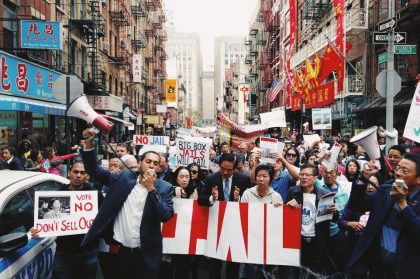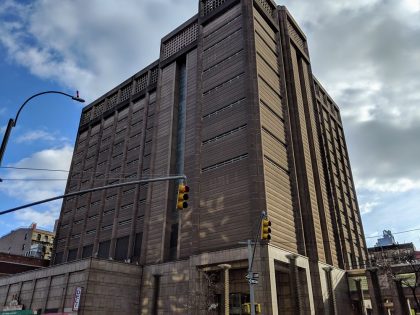Jail proposed for White Street is halted by judge
Activists in Chinatown successfully blocked the massive jail planned for the neighborhood by suing the city and challenging its plans to demolish two existing jail towers on White Street and build even higher.
Neighbors United Below Canal — the group that formed just to fight the jail proposal — said the judge ruled in favor of both their technical and quality-of-life arguments. The lawsuit charged that when the city switched its plans from 80 Centre to 125 White Street, it neglected to re-do the land use approval processes, such as the Environmental Impact Statement, and the subsequent approvals from the City Council must therefore be “annulled.” And the judge agreed that because of the severe health impact 9/11 had on Chinatown, the pollution caused by massive construction would critically damage the health of an already vulnerable population of seniors.
“The ruling validated everything we had been telling the mayor, Corey Johnson, Councilwoman Chin and the Planning Commission — but they ignored us,” said Nancy Kong, the president of the coop board at Chatham Towers and a self described “pissed off resident.” “Now it is for everyone to see that what they did was illegal and totally motivated by politics and not by due process. The lack of regard for the voices of the people should be on their political obituaries.”
The ruling is of course a huge victory for local residents and the broader neighborhood — not just Chinatown but the Civic Center and eastern Tribeca would have felt the impact of this, and still will if the city continues down this path. If it takes three years for the city to build Bogardus Garden, extrapolate from there what it would require for the city to build a 29-story tower, and then add in the miles and miles of garbage the demolition would create.
But let’s hope this also exposes the ridiculous scheme to dovetail jail reform with what must be some sort of bonus for the building trades and make the city reconsider what it is *really* trying to achieve by closing Rikers. Over and over again at the hearings that took place here for the Manhattan jail, city staffers would earnestly explain how progressive jails require new construction — and it just rang hollow. It paired progressive reforms (roomier cells, more natural light, better facilities for visitors) with decades-long construction projects in dense neighborhoods that already bear their fair share of municipal burdens (see also Mott Haven in the Bronx and Kew Gardens in Queens, where neighborhood groups also sued the city).
In contrast, the city’s efforts to depopulate the jails was smart and right-thinking and successful — during the coronavirus, the mayor announced the jail population was now below 4000, down from a high of 11,000 when he took office in 2013. Already this is progress and must be applauded. Buildings at Rikers have already closed. So why not redesign what’s left and rebuild that physical plant, now that it is more than half empty? Why not use NYC Ferries to take families and lawyers to Rikers? The city just spent $325 million building ferry docks on the East River, after all. That is bound to reduce what the city says is $31 million required to transport prisoners to courthouses around the city.
The abuses at Rikers were shameful. But the city in all its zeal over the borough-based jail program never really explained how those abuses would end just because of improvements to the inmates’ physical plant. Somehow reforming the Department of Corrections is the last consideration here. As recently as August, the feds accused Corrections of failing to institute the reforms it ordered five years ago.
Keep in mind a couple other factoids when mulling this issue: The city’s Independent Budget Office estimates that it costs $167,731 to hold a detainee per year. In 2019, the comptroller put the number higher: at $337,524 per inmate, or $925 a day (vs. $30,000 a year for a public school student). The two existing tower jails at 125 White currently house nearly 1000 inmates, which is what the city was proposing for the new jail. So.
And in July, the city pushed off the financing for the jails to the fiscal 2025-2029 plan, which hopefully is one more reason to go back to the drawing board and create real reform that is not at the expense of city neighborhoods.















I have a funny feeling the Mayor (or his wife) may have received a sweet deal ($$$, we know at least his wife is motived by $$$) to close Rikers and have the land for building housing. Rikers should just be renovated. As the article mentions, prisoners went from 11k – 4k that means there is space to move inmates around and work on some parts of the facilities.
This is great news. The plan was horrible even before the pandemic, but now with pandemic and budget crisis, this $10 billion (sure to be double that or more, the way government projects go) project is just insane to even consider.
Agreed: Reform the jail/prison system and rebuild Rikers; scrap this borough jails expansion plan. This was always a bait-and-switch project: “We want to reform the criminal justice system” does not in any way entail or imply “We have to destroy Rikers and build bigger prisons/jails in your neighborhoods.” Indeed, the latter can happen without any improvement of “the system”. If the project went through, it might just have been money completely wasted, just moving the problem around to different geographical locations, without any significant improvement of criminal justice system at all.
(As for the reduction of the current incarceration population, some of that can be justified where offenses were minor, but is all of it? Is it partly responsible for the increase in crime? I don’t know the stats on how the reduction was achieved, and what the criteria for release were)
Trial by Zoom. Problem solved.